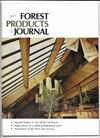Interactive Evolutionary Design of Handbag Integrating Bamboo Weaving Material
IF 1.2
4区 农林科学
Q3 FORESTRY
引用次数: 0
Abstract
The integration and development of fashion products and intangible cultural heritage have gradually become the highlight of product design. Following thousands of years of evolution, bamboo weaving patterns offer a rich resource library for use by designers. However, the designers cannot predict which bamboo weaving pattern can be adopted into women’s handbags to satisfy consumers’ aesthetics. Therefore, taking the form design of women’s handbags as an example, this study develops an artificial intelligence-based program through which consumers can codesign with designers to effectively match the bamboo weaving pattern with the design style of women’s handbags. First, based on the coding, selection, and mutation processes of interactive genetic algorithms, consumer preferences, and perception evaluations are effectively incorporated into product design. This ensures that the evolved product solutions meet consumer preferences. Second, considering evaluator fatigue in human–computer interaction evaluation, the decision tree algorithm is used as a proxy for evaluation. Finally, the developed interactive system supports mass-generated bamboo-woven bags of different styles, allowing prediction of consumers’ preferences for the design of women’s handbags. Furthermore, the system can assist designers and bamboo craftsmen in designing other bamboo or wooden products.竹编材料手提包的交互式进化设计
时尚产品与非物质文化遗产的融合发展逐渐成为产品设计的亮点。经过数千年的演变,竹编图案为设计师提供了丰富的资源库。然而,设计师无法预测哪种竹编图案可以被采用到女性手袋中,以满足消费者的审美。因此,本研究以女性手袋的造型设计为例,开发了一个基于人工智能的程序,通过消费者与设计师的协同设计,将竹编图案与女性手袋的设计风格进行有效的匹配。首先,基于交互式遗传算法的编码、选择和突变过程,将消费者偏好和感知评估有效地纳入产品设计中。这确保了不断发展的产品解决方案满足消费者的偏好。其次,考虑到人机交互评估中的评估者疲劳,采用决策树算法作为评估的代理。最后,开发的交互系统支持批量生成不同款式的竹编包,预测消费者对女性手袋设计的偏好。此外,该系统还可以帮助设计师和竹工匠设计其他竹木产品。
本文章由计算机程序翻译,如有差异,请以英文原文为准。
求助全文
约1分钟内获得全文
求助全文
来源期刊

Forest Products Journal
工程技术-材料科学:纸与木材
CiteScore
2.10
自引率
11.10%
发文量
30
审稿时长
6-12 weeks
期刊介绍:
Forest Products Journal (FPJ) is the source of information for industry leaders, researchers, teachers, students, and everyone interested in today''s forest products industry.
The Forest Products Journal is well respected for publishing high-quality peer-reviewed technical research findings at the applied or practical level that reflect the current state of wood science and technology. Articles suitable as Technical Notes are brief notes (generally 1,200 words or less) that describe new or improved equipment or techniques; report on findings produced as by-products of major studies; or outline progress to date on long-term projects.
 求助内容:
求助内容: 应助结果提醒方式:
应助结果提醒方式:


